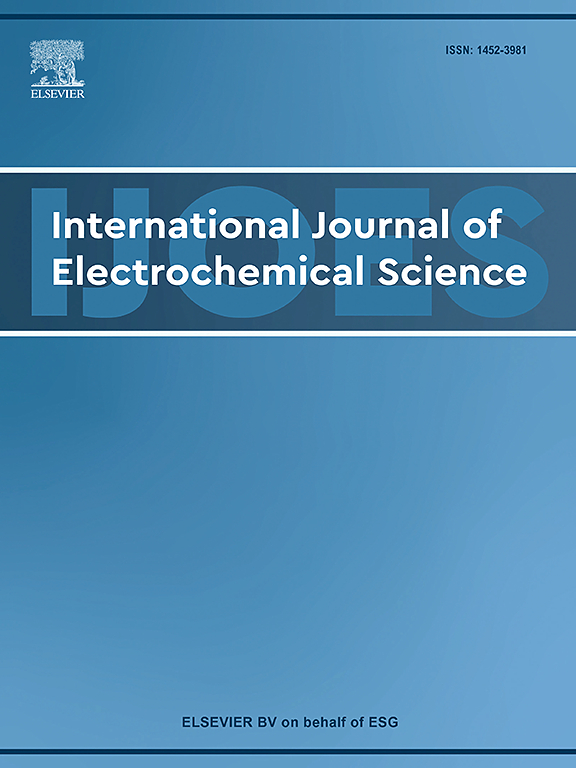Influence of chromium content on the hydrogen storage and corrosion behavior of Mg-Ca-Si-V-Cr amorphous alloys
IF 2.4
4区 化学
Q4 ELECTROCHEMISTRY
International Journal of Electrochemical Science
Pub Date : 2025-05-12
DOI:10.1016/j.ijoes.2025.101066
引用次数: 0
Abstract
To enhance the overall efficiency of Mg-based alloys, Mg-Ca-Si-V-Cr amorphous alloys with various Cr contents were prepared using the mechanical alloying method. The alloys were then characterized using X-ray diffractometer, energy dispersive X-ray fluorescence, scanning electron microscope, energy dispersive spectrometer, and electrochemical workstation to measure the mechanical property, hydrogen storage property, charge/discharge cycle stability, and corrosion resistance of the alloys. The results indicated that the Mg-Ca-Si-V-Cr magnesium-based alloys with varying Cr contents were amorphous in structure, featuring a uniform distribution of alloy particles on their surfaces. These alloys demonstrated outstanding overall performance. At a Cr content of 6 wt%, the synthesized Mg-Ca-Si-V-Cr alloy powder possessed the maximum peak load of 10.12 kN, indicating higher load-carrying capacity. The alloy achieved optimal hydrogen absorption performance, with a maximum H2 absorption equal to 4.23 wt%. Its value dropped to 3.96 wt% after 10 min of hydrogen absorption, accounting for 94 % of the maximum absorption capacity. Moreover, the alloy displayed a distinct H2 desorption plateau, providing a desorption pressure of approximately 0.5 MPa. The discharge capacity of the fabricated Mg-Ca-Si-V-Cr alloy initially increased from 475.67 to 495.88 mAh/g before gradually declining to 412.28 mAh/g during testing, achieving a maximum capacity retention rate of 86.78 %. At this time, magnesium-based alloy demonstrated a minimum corrosion current of 1.84 × 10⁻6 A/cm2 and a maximum corrosion potential of −0.373 V. These results indicate that the Mg-Ca-Si-V-Cr alloy powder achieved its best overall performance at a Cr content of 6 wt%.
铬含量对Mg-Ca-Si-V-Cr非晶合金储氢和腐蚀行为的影响
为了提高mg基合金的整体效率,采用机械合金化法制备了不同Cr含量的Mg-Ca-Si-V-Cr非晶合金。采用x射线衍射仪、能量色散x射线荧光、扫描电镜、能量色散光谱仪和电化学工作站对合金进行表征,测定合金的力学性能、储氢性能、充放电循环稳定性和耐腐蚀性。结果表明:不同Cr含量Mg-Ca-Si-V-Cr镁基合金均为非晶态,合金颗粒在表面分布均匀;这些合金表现出优异的综合性能。当Cr含量为6 wt%时,合成的Mg-Ca-Si-V-Cr合金粉末的最大峰值载荷为10.12 kN,具有较高的承载能力。该合金具有最佳的吸氢性能,最大吸氢量为4.23 wt%。吸氢10 min后,其值降至3.96 wt%,占最大吸氢量的94 %。此外,合金表现出明显的H2解吸平台,提供约0.5 MPa的解吸压力。制备的Mg-Ca-Si-V-Cr合金的放电容量从475.67增加到495.88 mAh/g,在测试过程中逐渐下降到412.28 mAh/g,最大容量保持率为86.78 %。此时,镁基合金的最小腐蚀电流为1.84 × 10⁻6 a /cm2,最大腐蚀电位为−0.373 V。结果表明,当Cr含量为6 wt%时,Mg-Ca-Si-V-Cr合金粉末的综合性能最佳。
本文章由计算机程序翻译,如有差异,请以英文原文为准。
求助全文
约1分钟内获得全文
求助全文
来源期刊
CiteScore
3.00
自引率
20.00%
发文量
714
审稿时长
2.6 months
期刊介绍:
International Journal of Electrochemical Science is a peer-reviewed, open access journal that publishes original research articles, short communications as well as review articles in all areas of electrochemistry: Scope - Theoretical and Computational Electrochemistry - Processes on Electrodes - Electroanalytical Chemistry and Sensor Science - Corrosion - Electrochemical Energy Conversion and Storage - Electrochemical Engineering - Coatings - Electrochemical Synthesis - Bioelectrochemistry - Molecular Electrochemistry

 求助内容:
求助内容: 应助结果提醒方式:
应助结果提醒方式:


